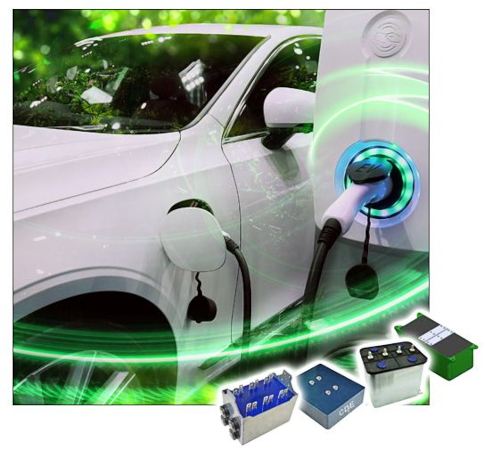High-voltage DC Link Capacitors Optimized for EV Fast Charging
An expanded portfolio of DC link capacitors from Cornell Dubilier supports next-generation level 3 fast chargers for electric vehicles.
Cornell Dubilier Electronics (CDE) has announced the expansion of its portfolio of standard high-power capacitors to help meet the growing demand for the high-voltage DC Link capacitors used in level 3 EV fast chargers.

EV fast charging. Image used courtesy of Tesla
CDE actively participates in the high-voltage DC link capacitor market for military and energy applications. It is now expanding its focus to capitalize on opportunities in EV charging.
The company recently enhanced its position in the high-power market through its 2021 acquisition of NWL’s custom capacitor division. The acquisition was made by the company’s CD Snow Hill, LLC subsidiary based out of North Carolina.
In addition to standard products, CDE offers a dedicated team of engineers to help design and manufacture custom DC link capacitors specific to the needs of EV fast charging platforms. The demanding, high-power requirements of Level 3 charging systems require capacitor solutions that have exceptional reliability and a long operating life across a wide range of environmental conditions.

DC Link Capacitors for EV Fast Charging. Image used courtesy of Cornell Dubilier
Level 3 Fast Charging for EVs
Level 3 charging, also known as DC fast charging, is the fastest and highest power charging configuration currently available for EVs. Unlike Level 1 and Level 2 chargers, DC fast charging bypasses the EV onboard charger (OBC), providing DC directly to the vehicle’s lithium-ion battery pack. By circumventing the voltage constraints of the OBC, DC fast chargers can charge at much higher voltages (400V and higher) and power levels (300kW and more).
The higher power levels of Level 3 systems allow EVs to replenish their batteries much faster, which is particularly important for long-range driving applications. For reference, a GMC Hummer EV pickup with a 213kW battery can be fully charged at a DC fast charging station in less than an hour.
In DC Fast chargers 3 phase, AC grid power is claimed to be the first power factor corrected and rectified to high-voltage DC. This high-voltage DC is then conditioned and level-shifted through an isolated DC-DC conversion stage to the specified voltage for charging the EV battery pack.
The DC Link capacitor plays a critical role in the DC fast charging conversion circuit by storing energy, filter, and interface between the input rectification and DC-DC conversion stages.

Level 3 fast charger block diagram. Image used courtesy of Cornell Dubilier
Characteristics of the DC Link Capacitor
CDE’s DC link capacitors are designed to accommodate the specific capacitance values required by fast-charging platforms. For reference, the company’s larger portfolio of high-power capacitors for military and commercial applications have specified capacitance values up to 50,000uF. The parts are available in metal or plastic packaging, have low specified inductance (< 5 nH) and ESR, and can support voltage levels up to 3800 Vdc. The capacitors can also handle the hundreds of amps of ripple current from the rectification stage and are well suited to the demanding environment of fast chargers with a life expectancy of 200,000 operating hours, more than 20 years.
A well-designed DC link capacitor can help optimize performance and reduce design time for fast chargers by mitigating circuit harmonics that can lead to excessive heating. Proper design also relaxes input/output filtering requirements and reduces parasitic inductance and ESR levels.

DC link EV charger capacitors. Image used courtesy of Cornell Dubilier
Future of EV Fast Charging
Accessibility to fast charging stations is essential to continued EV adoption, particularly for long-range use cases like interstate travel. Last year’s US Bipartisan Infrastructure Law allocated $5 billion over five years to create a network of EV charging stations along the US interstate highway system. The US government has also negotiated with Tesla to open up their proprietary network of fast chargers to the general public, including EVs from other manufacturers.
Moving forward, we can expect fast-charging power and voltage levels to continue to increase. During the Tesla Semi launch event last December, the company announced the first 1000-volt EV powertrain, along with its 1 MW ultra-fast charging station. The new, high-power charging stations will be able to charge vehicles three times faster than current platforms and will most certainly require higher-power components, including DC link capacitors.






